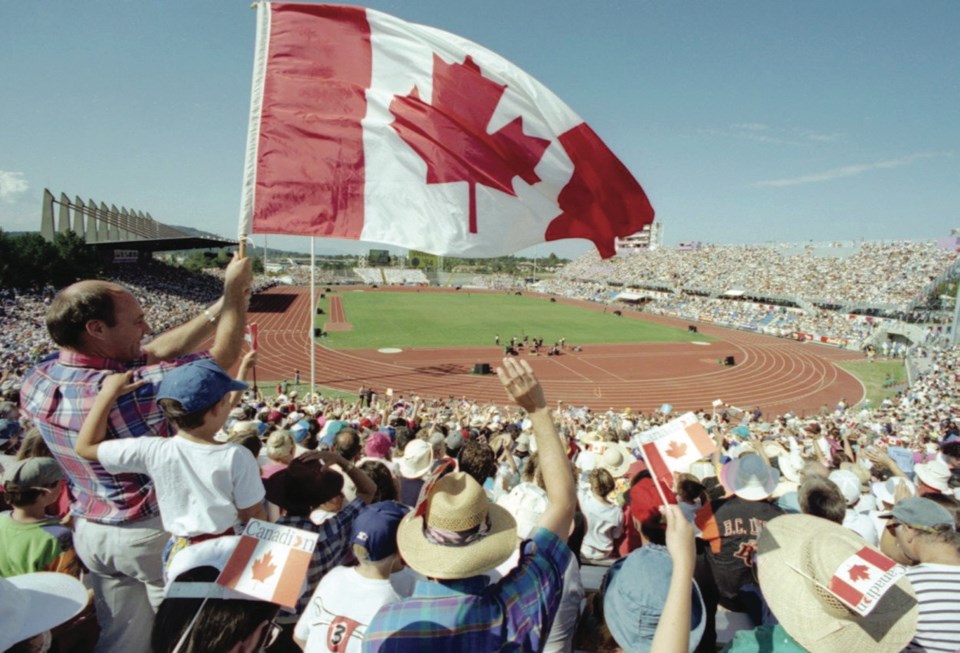The walls of the Pacific Institute for Sport Excellence, inside and out, are festooned with images of athletes who used its facilities to springboard to Olympics, Paralympics and World Cups long after the 1994 Victoria Commonwealth Games faded from view.
The dramatic posters outside, as you enter PISE, of Ryan Cochrane, Simon Whitfield, Paula Findlay, David Calder, Riley McCormick and national-team rugby players give way inside to framed prints of every Summer and Winter Olympics and Paralympics since 2000 and every B.C. athlete who has participated in each.
But the view will be toward the future as much as the past at the 20th anniversary celebrations planned Aug. 23 at PISE to commemorate the 1994 Victoria Commonwealth Games.
By far the greatest impact of the Games has been in terms of development legacy over the past two decades — and counting into the future.
Victoria basketball coaching legend Ken Shields was the first to suggest it, and Victoria Games CEO and president George Heller, and his second-in-charge Jim Reed, bought in big time. As hard as it was with all the funding demands to stage the Games, $10 million of the $162-million Games budget — a budget considered small even by 1994 standards — was set aside for a legacy fund to help develop future athletes for Canada.
When the Games made a profit of $5 million, unheard-of even then, that was added to the $10-million legacy fund. It stands today at $19 million, even after the economic hit of 2008.
That capital fund has been used to leverage myriad partnerships with private companies, provincial agencies, federal programs — the latter most notably Own the Podium — and national sports federations to create a training centre in Victoria that has produced numerous Olympians since 1994.
Canadian Sports Institute-Pacific, which operates campuses in Victoria, Richmond and Whistler, adds another layer to the development web.
The most visible physical legacy in Victoria is the PISE building on the Camosun College Interurban campus. PISE grew out of what was the Commonwealth Centre for Sport Development, which later became PacificSport and now PISE.
“It wasn’t about the two weeks [of the 1994 Games],” says Reed.
To drive home the point is a framed and signed poster inside the office of current PISE CEO Robert Bettauer. It shows the Canadian men’s rowing eight who won gold at the 2008 Beijing Summer Olympics.
Canadian rowers are among the athletes who have used the services of PISE and CSI-Pacific to springboard to world podiums. Other sports federations that have used Victoria as a main training hub are swimming, triathlon, cycling, rugby and middle-distance track.
“PISE would not exist if not for the Victoria Commonwealth Games 20 years ago,” said Bettauer.
“It’s a living legacy of a Games experience that is still carrying on. We work closely with CSI-Pacific and federal and provincial partners and focus mainly on providing services to the athletes — from performance meals that are served here at PISE, Saanich Commonwealth Place, Elk Lake or the rugby centre in Langford to enhanced massage and physiotherapy to detailed video analysis of performance.”
This is the software.
Twenty years on, some of the 1994 Games hardware is also still providing legacy benefits.
The region didn’t get a new arena out of the 1994 Games because with time running out and organizers worn down and disillusioned by the municipal bickering, they decided to stick with the old Memorial Arena for the gymnastics competition.
Save-on-Foods Memorial Centre finally came a decade later, after much more civic acrimony.
Yet out of Saanich Commonwealth Place pool have come two-time Olympic-medallist swimmer Cochrane, all four Canadian swimming medallists from the 2013 world aquatic championships, two-time Olympic diver McCormick and triathletes such as two-time Olympic medallist Whitfield and others who have used the facility to great advantage alongside thousands of citizens.
“Twenty years later, this facility is still world-class,” said Cochrane, earlier this spring at the Canadian trials for the 2014 Glasgow Commonwealth Games.
The 1994 Victoria Games velodrome at Juan de Fuca has had a more troubled history — as has been the post-Games pattern for velodromes around the world. Velodromes seem to be the white elephants of any Games.
But track cycling is making a rebound once again at the 1994 Games velodrome — even helping produce track cyclist Gillian Carleton, who won bronze at the 2012 London Summer Olympics.
As part of this track cycling renaissance, PISE has partnered with the Greater Victoria Velodrome Association to buy 38 training bikes for aspiring young cyclists.
“It was like when we provided $300,000 and partnered with additional funding from Rowing Canada and Own the Podium to build the [indoor rowing machines] ERG Centre [adjacent to the PISE building] which our Canadian rowers are using now to get ready for the 2016 Rio Summer Olympics,” said Bettauer.
PISE plans on continued growth. A $1-million outdoor running track around the existing soccer pitch is being added with fundraising well under way. The larger project is a $10-million addition to the existing PISE building that will include a third gymnasium and more room for various kinds of training.
“People around the country always ask me: ‘What is the deal with Victoria? Why does it produce, per capita, the highest number of international athletes in Canada?’” notes Bettauer, three-time Canadian singles tennis champion, who both played in the Davis Cup and coached Canadian teams in the Cup, along with coaching Canada at the 1988 Seoul and 1992 Barcelona Summer Olympics.
“Sure, it’s the weather and an active lifestyle people here cherish. But mainly, we have built an incredible sports system. I want all those 1994 Games volunteers, and anybody else from the community who comes out in August to celebrate the 20th anniversary of the Victoria Commonwealth Games, to realize this is your baby. You helped create this. And there are so many more next steps to come yet. The Games are still carrying on.”
For Commonwealth Games 20th-anniversary reunion information, go to: victoria94celebration.piseworld.com.



